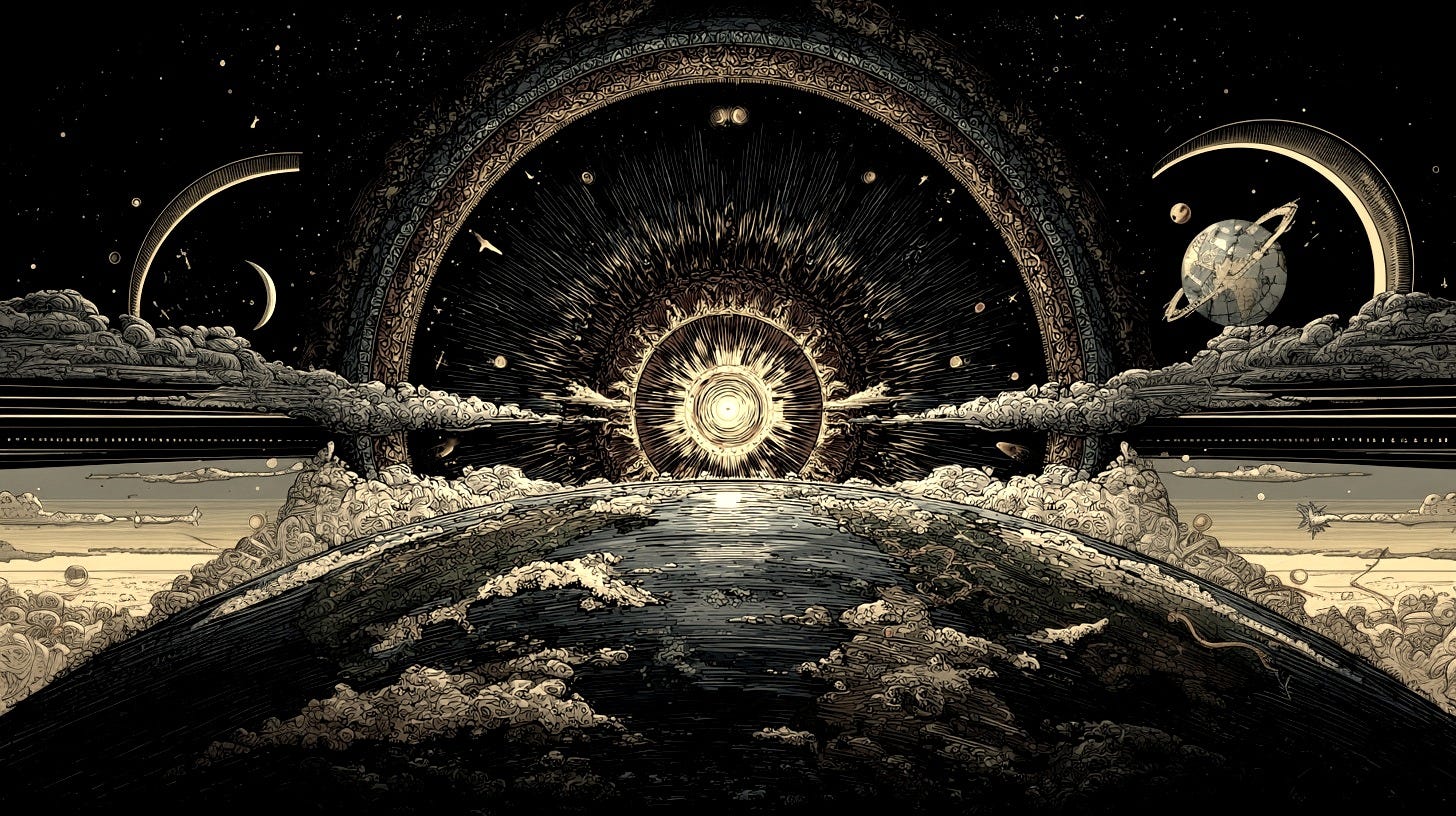The idea is that there is a kind of memory in nature.
Rupert Sheldrake
Spotlight of the week
Today, at the summer solstice, our 4.6-billion-year-old star reaches its zenith — the longest day of the year in the Northern Hemisphere, and a cosmic moment of peak light and alignment. Across cultures and centuries, people have celebrated this triumph of the Sun, sensing a deep harmony as the Earth tilts closest to its life-giving source.
Biologist Rupert Sheldrake once proposed that fields of information, like light from the Sun, organize the forms of nature. In his view, the Sun might even be conscious — its vast, pulsing electromagnetic fields serving as an interface for awareness on a stellar scale. Centuries earlier, William Harvey, discoverer of blood circulation, likened the Sun to “the heart of the world,” pumping vitality through the cosmos just as the heart sustains the body. Science sees energy; philosophy sees order; ancient myth saw divinity. All agree on this: the Sun does not merely shine — it organizes life.
This Week in Technology
SoftBank’s $1 Trillion AI Complex Ambition
SoftBank founder Masayoshi Son is pushing a colossal $1 trillion plan to build an AI and robotics manufacturing hub in Arizona. He’s courting partners like TSMC and Samsung and seeking U.S. government incentives to realize this “next Silicon Valley” for robots and AI. The project is still in early stages with no guarantee, but it aligns with SoftBank’s aggressive AI investments – including a role in the $500B Stargate AI infrastructure project – to bolster U.S. tech capacity and jobs. If it comes to fruition, the complex would address labor shortages by rolling out AI-equipped factories across the country.
Read More
Mira Murati’s New AI Startup Gets $2B Seed Boost
Former OpenAI CTO Mira Murati has secured a staggering $2 billion seed round for her stealthy new venture, Thinking Machines Lab. The six-month-old startup – now valued at $10 billion – remains secretive about its work, but Murati’s star power and a team of ex-OpenAI researchers (including co-founder John Schulman) helped draw one of the largest seed investments ever. Andreessen Horowitz led the funding, betting that Murati’s lab could be building the next big leap in AI. Murati, who left OpenAI after clashing with Sam Altman’s leadership, is now poised to push AI research in bold new directions.
Read More
Midjourney Jumps from Images to Video
AI art platform Midjourney has launched its first video generation model, allowing users to “animate” a single image into a 5–20 second clip. The new V1 video model works within Midjourney’s workflow: you upload or generate an image, choose a motion setting, and watch it come alive as a short animation. Early adopters are sharing impressive clips made with V1, which positions Midjourney against rivals like Google’s and OpenAI’s experimental video tools. This image-to-video leap is exciting for creators, though it raises familiar challenges around copyright (Midjourney is already facing lawsuits over its training data) and the need for responsible use of AI-generated content.
Read More
Your Brain on ChatGPT – a Cognitive Red Flag
A new MIT study using brain scans has found that relying on ChatGPT for writing can markedly reduce your mental engagement. Students who used the AI assistant to help draft essays showed lower activity in memory and attention areas of the brain and struggled to remember content they themselves “wrote” with AI help. Researchers call this effect “cognitive debt,” where the short-term ease of offloading thinking to AI may lead to long-term costs in critical thinking, creativity and memory. In short, while ChatGPT can make writing feel effortless, over-reliance could dull your cognitive fitness over time – a finding that has educators and users rethinking how (and how much) to integrate AI into learning.
Read More
Tune in while you read
This Week in Health
Magic Mushroom Relief for Depression
A single dose of psilocybin – the active compound in “magic mushrooms” – produced dramatic improvements in depression scores in a new clinical study. Patients who received a guided psilocybin session saw their depressive symptoms plummet, with many reporting a renewed sense of perspective and well-being shortly after the one-time treatment. The research suggests psilocybin acts as a mental “reset button,” helping brains break out of entrenched negative pathways. Though the results are promising (with effects lasting weeks or even months), scientists caution that this therapy is done under controlled conditions with therapeutic support. The findings add to growing evidence that psychedelic-assisted therapy could be a game-changer for hard-to-treat depression.
Read More
‘Trojan Horse’ Cancer Therapy on NHS
In a world-first, Britain’s NHS is deploying a new “Trojan horse” drug to fight an aggressive form of blood cancer. The treatment, called belantamab mafodotin (Blenrep), sneaks toxic molecules into multiple myeloma cells by disguising them as harmless antibodies – a strategy that destroys the cancer from the inside while sparing healthy cells. Clinical trials showed the therapy can halt myeloma progression for around three years, compared to barely one year with standard treatments. About 1,500 patients annually will be eligible in England, where this approval marks a milestone for antibody-based “smart bomb” treatments. Doctors say it will significantly extend patients’ lives and cut side effects, by delivering chemo payloads directly to cancer cells like a stealth assassin.
Read More
Light-Activated Antibiotic Cleans Up Safely
Scientists have engineered a new form of penicillin that stays inactive until green light shines on it – a breakthrough to curb antibiotic resistance and side effects. Dubbed Penicillin-PPG, the drug is coupled with a light-sensitive blocker that keeps it from killing bacteria until a clinician illuminates the infection site with a green LED. In lab tests, this on-demand antibiotic wiped out bacteria in lit areas of a petri dish while leaving the dark side untouched. The innovation means doctors could activate antibiotics only where needed (for example, at an internal infection via an endoscope light), preventing excess drug from polluting the environment or gut microbiome. It’s a creative step toward more precise, eco-friendly infection control – literally using light to zap germs when and where it’s safe to do so.
Read More
DNA ‘Glue’ for Anti-Aging
A team in Australia has found a protein that acts like a repair glue in our cells, fixing DNA breaks and potentially staving off neurodegenerative disease. The protein, called PDI, was already known for helping fold other proteins, but researchers discovered it can relocate into the cell nucleus and mend damaged DNA strands – especially in neurons, which don’t normally regenerate. In experiments, cells without PDI couldn’t repair DNA damage, but adding it back restored their self-repair ability. And in aging zebrafish, boosting PDI levels protected brain cells from the usual DNA wear-and-tear of aging. The findings raise hopes that enhancing PDI’s action could slow the progression of disorders like Alzheimer’s and ALS by keeping neurons intact longer. (Intriguingly, cancer cells also exploit PDI to resist therapy, so future medicine might toggle this protein off in tumors and on in neurons as needed.
Read More
The sun is the spring that drives all. The earth is simply a mass of iron charged like a storage battery by the mighty sun.
Nicola Tesla
This Week in Science
Infrared Contact Lenses for Night Vision
Scientists in China have developed a prototype contact lens that allows wearers to see in the near-infrared spectrum without bulky goggles. The lens is infused with special nanoparticles that convert invisible infrared light into visible colors, effectively giving the user night vision in full color. Remarkably, the technology even worked with the wearer’s eyes closed, as infrared signals penetrated the eyelids and were perceived as flashes of light. It’s still early days for this sci-fi innovation, but it points toward a future of super-vision enhancements – essentially turning ordinary eyes into IR-sensitive cameras.
Read More
Plant Power Against Microplastics
Researchers have discovered that natural extracts from okra and fenugreek can remove up to 90% of microplastics from water. These plant-derived polymers act as a biodegradable flocculant, causing tiny plastic particles to clump together and sink, so they can be filtered out. In lab tests, the okra and fenugreek compounds worked across both freshwater and saltwater, outperforming traditional synthetic chemicals. The approach offers a cheap, non-toxic way to clean plastic pollution from wastewater before it reaches oceans – using kitchen crops to tackle a modern environmental menace.
Read More
Mysterious Signals Under Antarctic Ice
A cosmic detector flying over Antarctica has picked up bizarre radio pulses emerging from deep beneath the ice – signals that seem to defy the laws of physics. The pulses, detected by the ANITA balloon experiment, came from an angle that would require particles to have traveled through thousands of miles of Earth’s rock. According to the Standard Model, any normal particle (like a neutrino) should have been absorbed long before making that journey. Scientists have ruled out instrument error and known particles, leaving the tantalizing possibility of new physics at play. The findings, published in Physical Review Letters, have researchers buzzing that these “impossible” signals could be hints of undiscovered particles – a reminder that even deep in the polar ice, the universe can still surprise us.
Read More
Infinity Gets Even Weirder
A gathering of mathematicians in the Arctic Circle has posed a profound question: Is the mathematical universe mostly orderly or chaotically wild? The debate was sparked by the discovery of two new kinds of infinity (so-called large cardinals) that don’t slot neatly into the known hierarchy of infinities. These bizarre new infinities “exploded” the usual rules, suggesting far more untamed complexity lurking in math’s foundations than expected. Some researchers are excited, seeing the potential for fresh axioms and insights, while others are skeptical since in the lofty realm of the infinite many things can’t be proved definitively. The upshot: our understanding of infinity – and whether math is fundamentally orderly – remains unsettled, with new discoveries tilting the balance toward chaos.
Read More
Editors Choice of the Week
The bells are ringing from the future. Can you hear the music?
This week’s must-read is Goddesses, Chrysalises, and the Destiny by
— a beautiful, hopeful and important piece.
It feels like one of the stories we’ve all been waiting for.
Did you see…? That writing on your visual cortex? Not yet, but most likely 6-12 months we will be able to restore vision for someone that is completely blind.
Did you think…? You could be going to the Adromeda Galaxy in one minute? Only one thing, no one there to great you when your back.
Did you hear…? About the Biocomputer CL1 back in March? The device which supposedly should be available this month fuses living human brain cells with silicon circuitry. The system, described as a “body in a box,” keeps lab-grown neurons alive on a microchip and lets them communicate with traditional electronics in both directions.
Did you read…? From Homesteading to “Villaging” The piece taps into a growing longing for community in an age of urban isolation, suggesting that our future may lie in banding together like a village rather than each person turning their home into a self-sustaining island.
Closing the loop with a beautiful from Alexandra Elle the Sun will rise and set regardless. What we choose to do with the light while it’s here is up to us.
xxx
FusionNote
Because the future is brighter when we build it together, I’d love your help—whether that’s sharing stories, suggesting breakthroughs, or simply adding a drop of your own creativity to our cosmic cauldron. Let’s fuse knowledge, wonder, and hope into something beautiful.
















Share this post